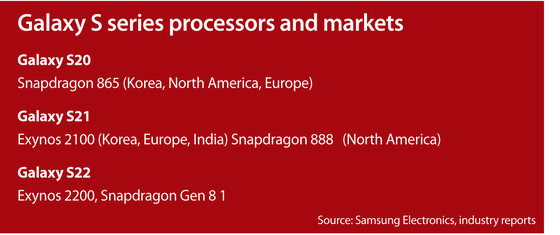Galaxy S22 set to be key test for Samsung Electronics
Published: 05 Feb. 2022, 06:00
![A rendering of the Galaxy S22 series [LETSGODIGITAL]](https://koreajoongangdaily.joins.com/data/photo/2022/02/05/13fc9caa-83b0-4d7d-806a-36f989c788f3.jpg)
A rendering of the Galaxy S22 series [LETSGODIGITAL]
Some Korean users of Galaxy S21 liken purchasing the smartphone to a luck of the draw. Will their model perform poorly in terms of processing speed or worse, will it overheat?
Samsung Electronics is hoping that the Galaxy S22, which features the company's newest processor the Exynos 2200, will help the Korean manufacturer rebuild its reputation.
Against this backdrop, the impending launch of the flagship line set for Feb. 9 will act as a key test for Samsung Electronics’ capability to build high-performing processors on top of the general importance placed on the S series.
“With the launch of the Galaxy S22 series, the market will look at how Samsung Electronics will ensure profitability under tough market conditions including increasing component prices,” said Greg Roh, head of research center at Hyundai Motor Securities.
“Another critical point will be whether the smartphones running on the new Exynos chip will meet expectations,” Roh said, “They are known for improving graphics processing, but the Galaxy S22 needs to deliver what it promised without overheating.”

It remains unknown which market will see the Exynos-based Galaxy S22 instead of Qualcomm’s Snapdragon 8 Gen 1, although multiple media outlets reported that European retailers have listed Exynos-powered Galaxy S22 ahead of the official launch. They speculate that North America and Korea will have Snapdragon.
When it comes to the predecessor S21, Samsung retailed Exynos 2100 devices in Korea, Europe and India and Snapdragon 888-powered models in North America.
The Galaxy S21 series, however, was met with waves of controversy, especially on its home turf, after its release last year. Many users complained about overheating and a slow-down in data speed especially when they played games or took photos and videos. Well-known tech YouTubers both at home and abroad jumped on the backlash, carrying out benchmark tests designed to compare the S21’s temperature to other models.
Despite the complex nature of the overheating issue, local users quickly pointed to Samsung’s processor as the culprit, citing the relatively weak performance of the graphics processing unit (GPU) capability in the Exynos 2100 compared to the Snapdragon chipset.
The smartphone maker tried to resolve the problem through a software update in June, stating “improvement of overheating” as one of purposes of the upgrade.
Still, holding Exynos wholly accountable for the problem could be misleading since users in North America where Snapdragon-powered S21 were sold also reported similar issues.
“At a more fundamental level, the problem could boil down to ARM’s Cortex X1 architecture used in both Exynos 2100 and Snapdragon 888,” said Jeong In-seong, a semiconductor specialist who authored “The Future of the Semiconductor Empire.”
He also pointed out that Samsung’s strategy of using reference chip platforms designed by other chipmakers is vulnerable when it comes to managing quality control.
“Since the process involves different parties and multiple steps, it could expose Samsung to more risks compared to Apple that designs CPUs [central processing unit], GPUs, operating system and devices on its own.”
Samsung’s recent Galaxy series showed lower average scores in computing power than the competing iPhone models, according to multiple benchmarking test tools like Geekbench.
The sales gap between the two premium models has also widened. Analysts estimated sales of Galaxy S20 and S21 dipped below the 30 million units each. The iPhone 11, on the other hand, was the best-selling smartphone in 2020 with sales estimated at 64.8 million, according to market tracker Omdia. The iPhone 12 sold even better, surpassing the 100-million-mark last year.
While little is known about the actual performance of the Exynos 2200, the new processor got off to a rough start.
Samsung Electronics was set to announce the introduction of the Exynos 2200 on Jan. 11, but that was delayed, which led some industry insiders to question had there been a hiccup in production.
The company, however, said that the schedule shift was due to the need to coordinate with clients and was not related to any production issues.
The electronics giant finally unveiled the Exynos 2200 on Jan. 18.
The highlight was the new GPU, branded as the Xclipse, which was jointly developed with Santa Clara, California's AMD.
However, Samsung Electronics stopped short of mentioning how much the new processor had been improved in CPU and GPU capabilities compared to the previous products.
“Exynos 2200 will likely show better performance particularly in terms of GPU,” said Roh, “It is the first mobile chip equipped with AMD’s graphics card architecture called RDNA 2 that has a good track record. And the adoption allows for real-time ray tracing in the Exynos chip.”
Ray tracing is a technique that simulates how light behaves in the real world and is considered essential to realistic and immersive graphics.
BY PARK EUN-JEE [park.eunjee@joongang.co.kr]










with the Korea JoongAng Daily
To write comments, please log in to one of the accounts.
Standards Board Policy (0/250자)